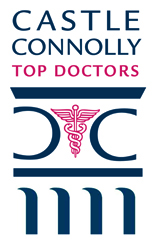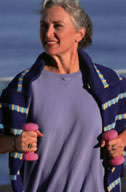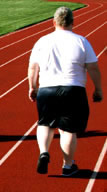|
Personal Conditioning
Individual conditioning and overall physical fitness are personal,
and should take into account how differences in personality and
background can influence the way people view personal health
considerations. This will include the various differences as to the
kinds of activities unique individuals are willing to do in maintaining
good health. There is not a "one-size-fits-all" approach.
The beginning point is to identify your specific fitness goals and then
to create a personalized plan appropriate for your age, gender,
interests, body type, current physical activity, and other health
considerations. There really is not a right or wrong way to achieve
personal fitness, as long as your plan needs to include the 7 fitness
elements listed below.
Are you a competitive athlete wanting to improve your performance? Are
you wanting to improve your general health? Are you generally a
physically active person or do you spend most of your time either
sitting at work or school and reclining at home? Are you recovering
from an injury or do you have a chronic illness? These factors are
important in identifying your individual fitness considerations.
The next step is to create a written, personalized workout plan and
establish a weekly schedule. This will be your road map to follow in
working towards your personally identified goals. Give consideration to
activities you will enjoy, your daily time constraints, and your
budget. Do you prefer activities with others or do you prefer to work
out in private? Are you more of an outside or inside person?
Ultimately, your plan should include activities for core body
conditioning, cardiovascular improvement, muscle strength and endurance
development, agility and flexibility, rest and recovery, and hydration
and general diet considerations.
If you have not been physically active in a long time or if you are
overweight, you should start with a simplified plan which includes the
three elements of (a) Walking, (b) Hydration and Diet, and (c) Rest and
Recovery. Follow your simplified program for two weeks to two months,
depending upon your current health. Once you are comfortable with this
level of exercise, start adding other elements of the program until you
have incorporated all the needed activities for good personal
conditioning.
A common mistake beginners can make is to try to do too much too soon.
This will lead to discouragement and possibly to injury. There is no
way to "short-cut" the safe process of improving your personal fitness
and health. Be patient. As long as you do not quit, you will gradually
notice improvement.
Self motivation is key to following your plan long term. Maintaining a
detailed log or diary of your daily workout helps many to stick with
their plan day after day, week after week. It can be a formal journal.
It can be a computer program or an online log, such as the President's Challenge.
It can even be a cell phone app. But keeping a written record and
tracking what you actually do in following your personal plan is a very
effective way to achieve long-term success.
Before
beginning a new conditioning program, you should consult you physician
to be certain your plan is appropriate for you and your current health.
Your physician may also have suggestions on how to make your plan be
more appropriate for you personally.
If you ever experience dizziness, become short of breath, or notice any
chest pain, stop and seek medical attention as soon as possible. These
are indications of serious and potentially dangerous health problems
that should not be ignored. This would apply whether you are doing your
fitness routine or just going about your normal daily activities.
ELEMENT #1 - WALKING:
Perhaps the single most effective exercise in your entire personal
conditioning plan is walking. It can provide many of the same personal
conditioning benefits as a running program, and is not as demanding on
your entire body. Walking can fit into any schedule and be done at any
location, including in your neighborhood, in a park, in a local mall,
or on a treadmill.
Unlike many sports where one leg may be used more than the other,
walking develops all of the muscles in both legs equally. By being
careful to hold your head up and body in good posture while you walk
will strengthen your core body muscles, especially the back and hips.
As your walking routine becomes easier and you are able to walk at a
faster pace or on a higher incline, you will also be improving your
aerobic fitness.
For people who have done little to no conditioning or exercise for the
past year or for people who are at least 40 pounds overweight, you can
download my Walking Conditioning Program to get yourself started.
ELEMENT #2 - CORE BODY CONDITIONING:
The core (or trunk) of the human body is your center of gravity and is
therefore central for all body movement. Core conditioning includes
many different muscles in the back, abdomen, and hips. If these are all
strong, your back is better protected, and both your posture and
balance will be better.
Core strengthening development is one of the most overlooked factors
in maintaining either general physical fitness or athletic competitive
conditioning. One possible explanation could be that the most commonly
mentioned core strengthening exercises are not good matches with many
individuals' unique personalities or body types. (If you don't like it,
you won't do it.)
If you are not sure about what core
strengthening exercises to do, a number are included in workout DVDs or
can be found in a number of locations online by searching for "core
conditioning". Choose at least two in the beginning. When they become
easy, add a couple more. Allowing for variety will make it easier to
maintain your core body workout plan long term.
While repetition is a fundamental aspect of strengthening your core
muscles, using the correct technique is also important. Pay attention
to your form. In the beginning, it might help to either do your
exercises in front of a mirror or have someone watch you to be sure you
are doing them correctly.
Most of the more popular core strengthening exercises require being on
the floor. If you have difficulty getting down and up from the floor,
then do them on your bed or pick ones you can do sitting in a chair.
Yoga and pilates also have movements which are quite effective in
developing core body strength if you would prefer doing those.
ELEMENT #3 - CARDIOVASCULAR DEVELOPMENT:
Cardiovascular exercise should not be overlooked in your personal
conditioning plan. It increases the amount of oxygen in your blood
system and your overall blood supply to your body. Your overall energy
and stamina will also increase, while reducing stress at the same time.
It helps your heart muscles become stronger and is beneficial in weight
loss.
Beginners should start slowly. Walking is fine until you get to where
you can walk a reasonable pace while carrying on a conversation and not
being out of breath. Then either pick up the walking pace or add
another cardiovascular activity.
Swimming, bicycle riding or spinning also are good beginner
cardiovascular activities. They reduce stress on the joints while
improving muscle strength and overall physical endurance. For both
swimming and biking, do not push yourself too much at first. Do what
you are able to do comfortably, gradually increasing your time and
speed. When you are comfortable with a 30-minute workout at a
reasonable pace, you can then add another cardiovascular activity to
your plan.
Other cardiovascular activities to consider are the traditional
children's hopscotch, skipping, jump rope, and jumping jacks, as well
as several more "adult" activities, such as rowing, elliptical trainer,
jogging, dance, yard work, aerobic classes, or climbing stairs or
hills.
Don't do squats or lunges because of the potential damage they can do to your knees.
Don't make the mistake of thinking more is better, however. Overdoing
your cardiovascular workouts can actually lead to a variety of
undesirable health problems. To be safe and after you have slowly
worked into it, limit your cardio workouts to about 30-45 minutes a
day, for about 4-5 days a week.
Be sure to drink an appropriate amount of water before, during and after your cardio exercise.
ELEMENT #4 - MUSCLE STRENGTH & ENDURANCE:
This element of personal conditioning applies to both men and women of
all ages. As with the other elements, the amount of regular weight
training should be gradually increased. Also, you don't have to belong
to a gym or own expensive weight lifting equipment. For example, just
walking up and down stairs and carrying some small hand weights when
walking are beneficial in increasing your muscle strength.
Endurance comes over time as you increase your muscle strength, along
with improved cardiovascular improvement. You will slowly start notice
your improvement as you go about your daily life, and especially when
doing housework or yard work.
ELEMENT #5 - FLEXIBILITY & AGILITY:
Stretching is an important part of exercise. Gentle stretching before
any workout is beneficial and recommended to help warm up your muscles,
which should help reduce chances of injury.
As part of good fitness, it is important to be able to move your joints
through the full range of motion as they are supposed to be able to do.
If you are unable to do so, check with your orthopedic surgeon to
determine if the problem is associated with the joint or if the problem
is just that muscles and tendons need to be gradually stretched out. If
so, ask your doctor if a few sessions with a physical trainer or
physical therapist might help you learn specific stretching techniques
for your problem. That might not be necessary, however, as your doctor
may be able to show you what you need to know.
Agility is an additional aspect of flexibility, and involves expanding
flexibility to incorporate many of the other elements of physical
fitness, including strength, endurance, balance, and general physical
coordination. This will improve over time as you progress on your
long-term fitness plan.
ELEMENT #6 - HYDRATION & DIET:
Being even a little dehydrated, can cause you to feel poorly, so how
you feel may be improved by making sure you are drinking enough water
each day.
Your body also needs a balanced combination of proteins, vegetables, and complex carbohydrates.
Your body prefers to draw its energy from complex carbohydrates. If it
can't get energy from carbs, it will start to draw energy from protein
-- from your muscle tissues. When you are working on a fitness and
conditioning program (especially cardiovascular and muscle strength
activities), you do not want your body's need for energy to work
against you, so be sure you are including an appropriate amount of
complex carbs in your daily diet.
Unrefined grains, wheat, oats, beans, pastas, and potatoes are examples
of complex carbohydrates that will provide the energy your body needs.
The simple carbohydrates, such as refined sugar, corn syrup, and
bleached flour, are not beneficial in providing sustained energy to
your body. It is reasonable to reduce simple carbs from your diet, to
the extent that you can.
Obviously, if you eat too much food each day, you will gain weight.
Skipping meals is not a solution, however. Your body does best if it
has regular, appropriately sized nutrition throughout the day. Many
people have better luck having 4 rather small meals (such as balanced
snack sized portions) rather than two or three big meals a day.
One shopping tip you may have heard before is to concentrate your
grocery shopping to the outside aisles of the store. This is where you
will find the fresh foods, including fruits and vegetables, meats, and
dairy products. The interior aisles are full of processed foods that
are not generally as healthy for you, so be very careful about how much
time you spend in the interior of the grocery store.
ELEMENT #7- REST & RECOVERY:
In order for your body to benefit appropriately from your fitness plan,
you need to include "rest and recovery" time in your weekly plan.
Working out 7 days a week can actually has a negative effect.
According to the American Academy of Orthopedic Surgeons, you should
"schedule regular days off from exercise and rest when tired. This will
help prevent overtraining and many overuse injuries. Fatigue, soreness,
and pain are good reasons to not exercise," because they are signs your
body needs to take heal.
Beginners should allow at least 3 days a week for rest and recovery. As
your conditioning improves, you can reduce that to just 2 days a week
off. And make sure you give yourself 7-8 hours of sleep every night.
AQUA-THERAPY / WATER EXERCISE:
For people who have problems with their knees or hips, who are
osteoporotic, who are recovering from surgery or injury, or who are
over substantially overweight, aqua-therapy is a very good way to
exercise. It permits you to protect your joints while getting doing an
effective, low impact workout. Water therapy provides good resistance
and easier motion in developing muscle strength, endurance, agility,
and flexibility.
You do not have to be able to swim to participate in these programs,
because they are generally done in shallow water. Other programs
involving water resistance to strengthen muscles can be done wearing a
lifejacket.
If you don't have access to a pool where you live or only have access
to a pool during the warmer months, there are several places in the Ft.
Bend County area where you can join aqua-therapy and aqua-aerobic
programs year round.
EQUIPMENT:
Some people prefer going to a gym to work out. Others prefer to buy one
or more pieces of exercise equipment and work out in the privacy of
home. Unfortunately, both of these two options can be expensive. The
good news is that with a little creativity in your workout plan, you
can have a very good program with very little expense. You also will
have an exercise program that you can easily pack and continue doing
when you travel.
Proper, well fitting shoes are important, and might be the most
expensive item you have to purchase. Working out in old shoes can cause
injuries, so pay close attention to the tread on the bottom of the
shoes. Once they start to show any wear, they need to be replaced.
A jump rope is a great, inexpensive piece of equipment for
cardiovascular conditioning that can be found at your local sporting
goods store. The length of the rope depends upon the height of the
user. An 8' rope is for people 5'6" or less, a 9.5' rope for 5'7"-6'2",
and a 10' rope for those 6'3" and over. If the rope seems too long, it
can be shortened to better fit the user.
Resistance bands come in different lengths and strengths, depending
upon what is best suited for your strength training exercises and your
current conditioning. They are not as intimidating as dumbbells and
weight machines for beginners, making resistance bands a good place to
start with your muscle strength plan.
— Tom Parr, M.D. |
|
COMMON SPORTS INJURIES & SAFE PARTICIPATION
Baseball & Softball
Basketball
Bicycling
Boating & Waterskiing
Cheerleading & Gymnastics
Dance
Fishing
Football
Golf
Horseback Riding
Ice Skating & Hockey
Martial Arts
Personal Conditioning
Running & Jogging
Skateboarding & Rollerblading
Skiing & Snowboarding
Soccer
Swimming
Tennis
Track & Field
Volleyball

SPORTS MEDICINE RECOGNITION

Recognized as one of the "Top Sports Medicine Orthopedic Surgeons in the USA" by Castle Connolly.
Dr. Parr has been named as an "Outstanding Orthopedic Surgeon of Texas", as seen in SPORTS ILLUSTRATED.

SPEAKER'S PROGRAM:
Dr.
Parr enjoys teaching parents and coaches on the various aspects of
sports safety. If you would like him to speak to your group, please
call us.


free Wi-Fi
for our patients
in our office

Follow us on Facebook

Mapquest

Medical Advice Disclaimer

|
|






